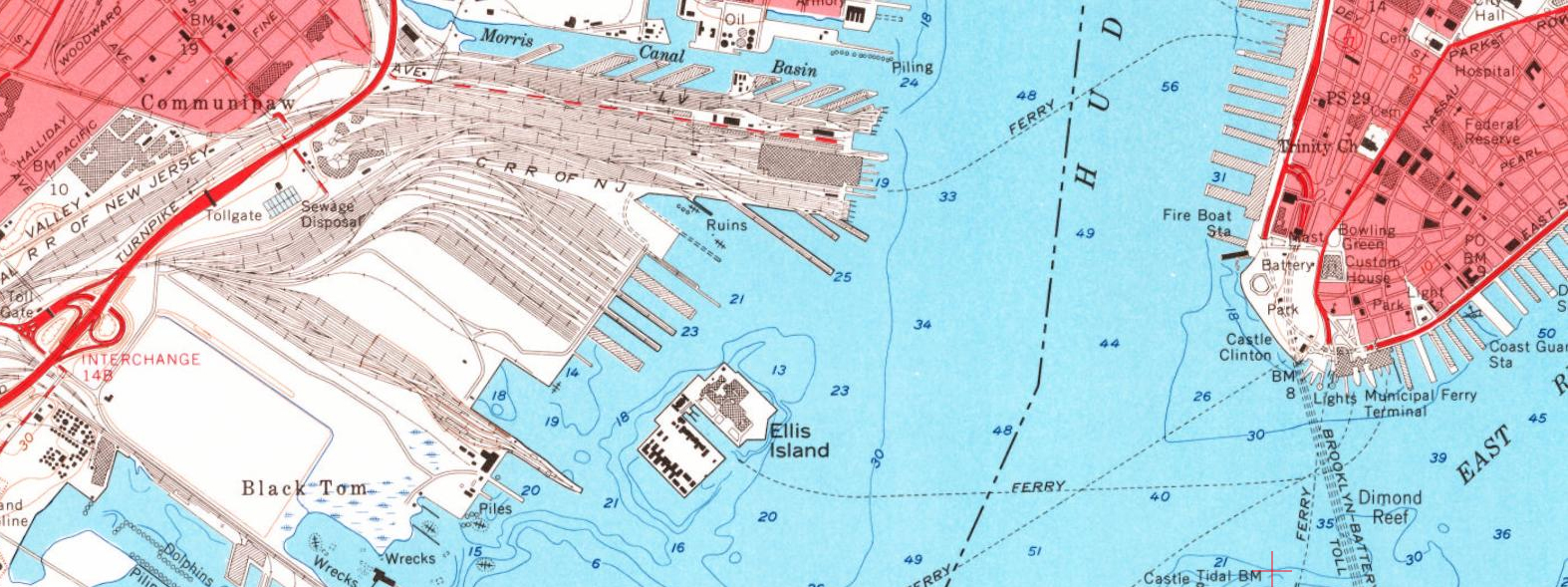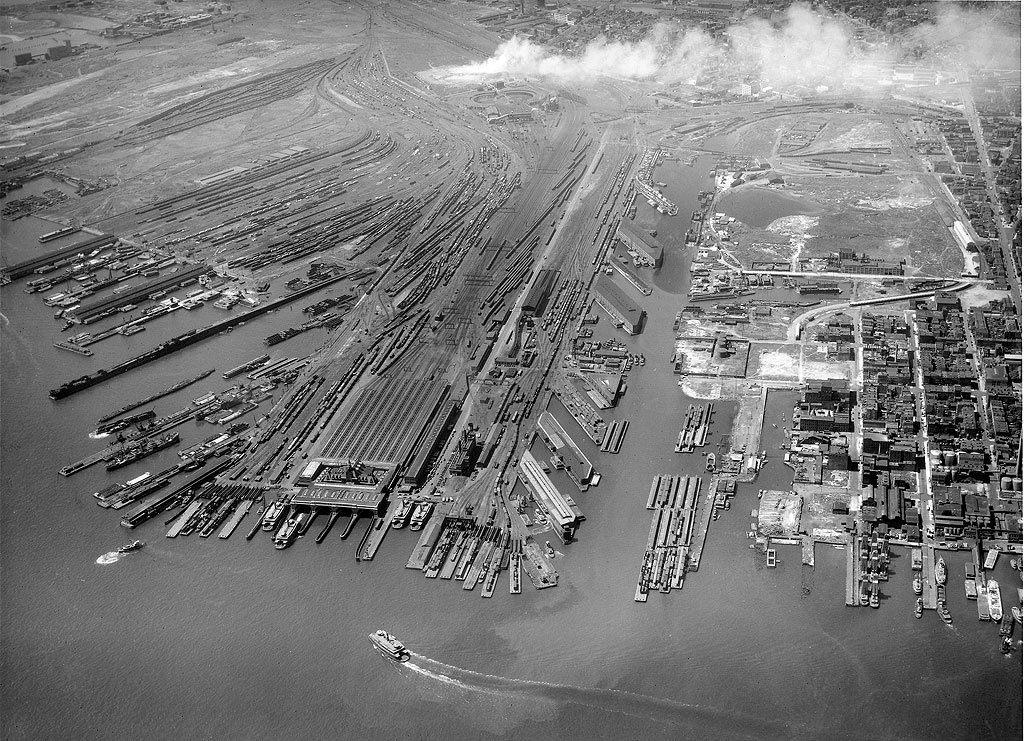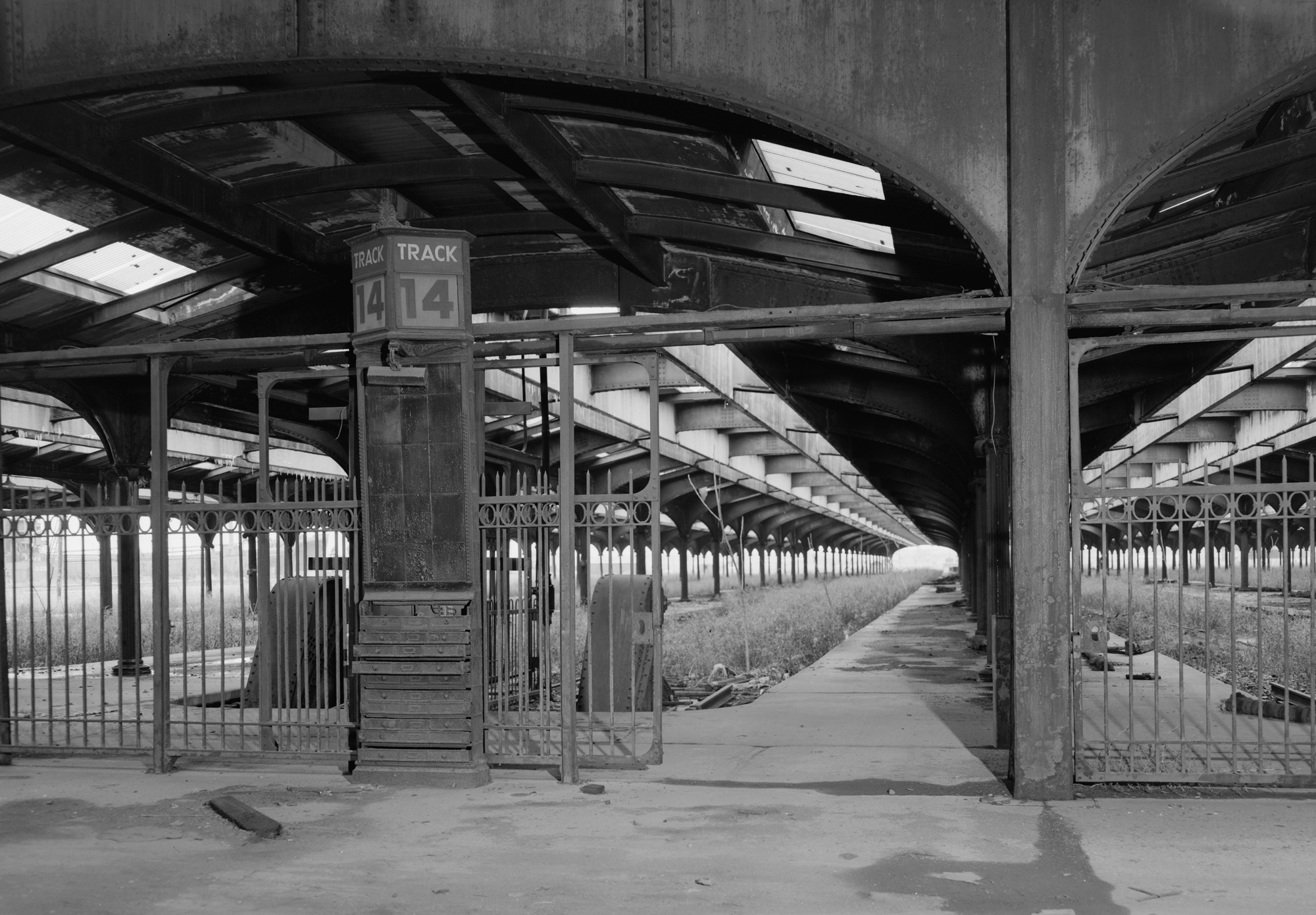Communipaw Terminal, CNJ's Waterfront Station (Jersey City, NJ)
Last revised: September 10, 2024
By: Adam Burns
Jersey City Terminal (JCT), also sometimes called Communipaw Terminal
(because it was built along Communipaw Cove) or Central Railroad of New
Jersey Terminal, was CNJ's impressive station along the Hudson River waterfront.
Like other major terminals situated on the west side of the river, New York City's Manhattan skyline loomed just across the water.
JCT was also quite likely Jersey Central’s most famous railroad station as it stood over three stories tall with a beautiful centered bell tower.
While the CNJ used the complex for its own trains allying roads like the Reading and Baltimore & Ohio also used the facility. Today, the station still stands and has been partially preserved as the Liberty State Park.
However, train service has long ago since ended (more than 40 years ago now) and today JCT is devoid of railroad tracks, save for its train sheds which still stand but are severely deteriorated and in serious need of repair and maintenance. There has been talk of reviving some service to the facility but no solid plans are currently in place.
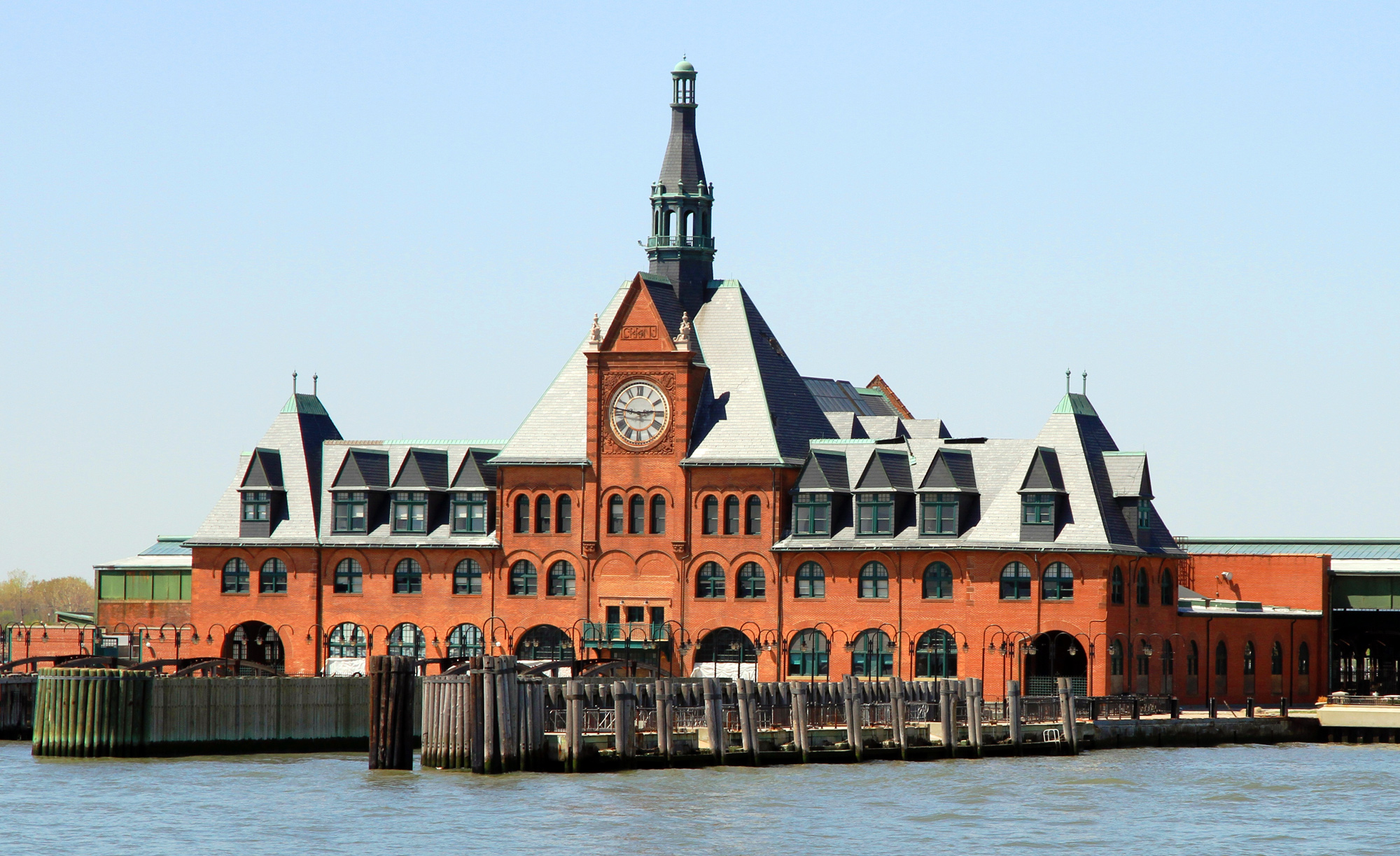 As seen from across the Hudson River is a present-day view of the Jersey City Terminal head house during October of 2013. The building is restored although the platforms are not. Photo by Wikipedia user, "Ingfbruno."
As seen from across the Hudson River is a present-day view of the Jersey City Terminal head house during October of 2013. The building is restored although the platforms are not. Photo by Wikipedia user, "Ingfbruno."History
For many railroads, except the Pennsylvania Railroad and New York Central, the New Jersey waterfront was as close as they would be able to get to the downtown New York City area of Manhattan.
So, to reach the district several railroad seither built or shared terminals along shores of the Hudson River directly opposite Manhattan and used a fleet of ferries to transport passengers directly into the downtown area.
These included all of the major players during the early 20th century:
- Delaware, Lackawanna & Western Railroad
- Central Railroad of New Jersey
- Baltimore & Ohio (through use of Jersey City Terminal),
- Erie
- Pennsylvania
- Lehigh Valley
- New York Central
The railroad's new terminal would be built along an empty, open stretch of waterfront known as Communipaw Cove.
This marshy area was once quite an excellent fishing hole although in 1860 the state of New Jersey granted the CNJ access to the area to begin construction of a small yard and passenger terminal.
Terminal Map
Originally opened in 1864 this first station proved inadequate by the 1880s and the Jersey Central looked to expand the entire complex.
To do so it required the CNJ to
bring in even more trash and fill to build up the waterfront and
construct a larger terminal. Despite outcries and legal battles with
local residents the railroad succeeded in further developing the
location.
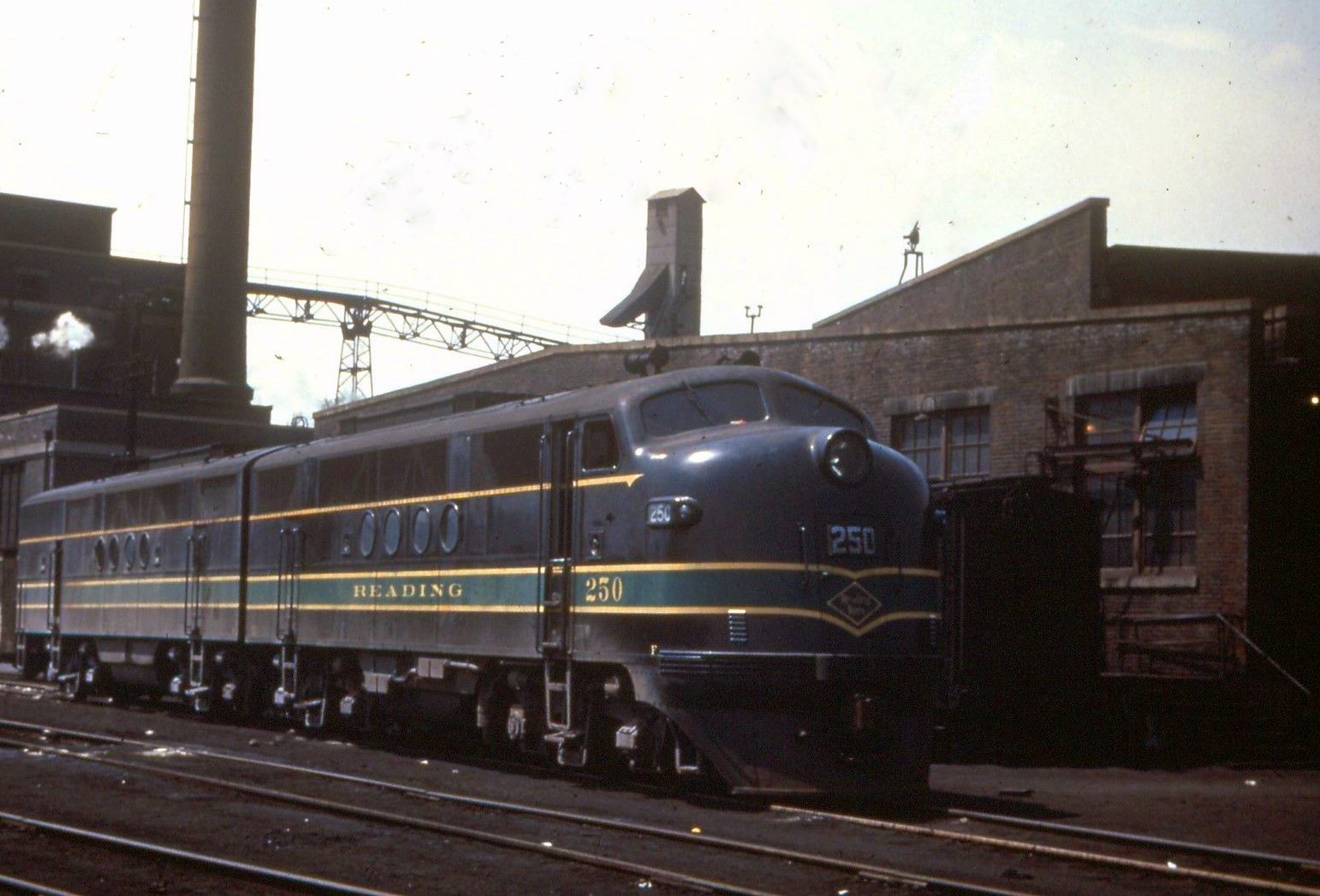 A handsome set of Reading FT's are seen here between assignments at Jersey Central's Communipaw Terminal, circa 1949/1950. The CNJ was a long-time Reading subsidiary.
A handsome set of Reading FT's are seen here between assignments at Jersey Central's Communipaw Terminal, circa 1949/1950. The CNJ was a long-time Reading subsidiary.The new terminal was to be constructed by architects Peabody & Stearns of Boston, Massachusetts and while the Jersey Central was never an extremely profitable railroad its new complex was quite stunning once completed in 1889.
Jersey City Terminal was designed in the Richardsonian Romanesque style, so named after famed architect Henry Hobson Richardson who sculpted buildings to mimic Medieval Europe castles and ancient structures.
As such, JCT, built almost entirely of red brick, featured arched windows along its three main floors, dormer windows, and steep pitched roofs.
Additionally, the building was accented with a central cupola and fine clock piece. The interior waiting room featured a balcony and cast iron trusses painted red and given a simple, but elegant starburst pattern.
The completion of Communipaw Terminal was not the only update the complex received.
The railroad also expanded the already massive yard complex to more than 1.5 miles from its main line connection to the west and included a roundhouse, marine repair yard, steamship piers, and freight piers.
This new yard not only was used for the many passenger trains using the terminal but also freight and, interestingly enough, immigrants arriving from nearby Ellis Island.
It is said that between 1890 and 1915 Jersey Central Terminal witnessed several million, mostly Italian and Irish, immigrants passing through the complex.
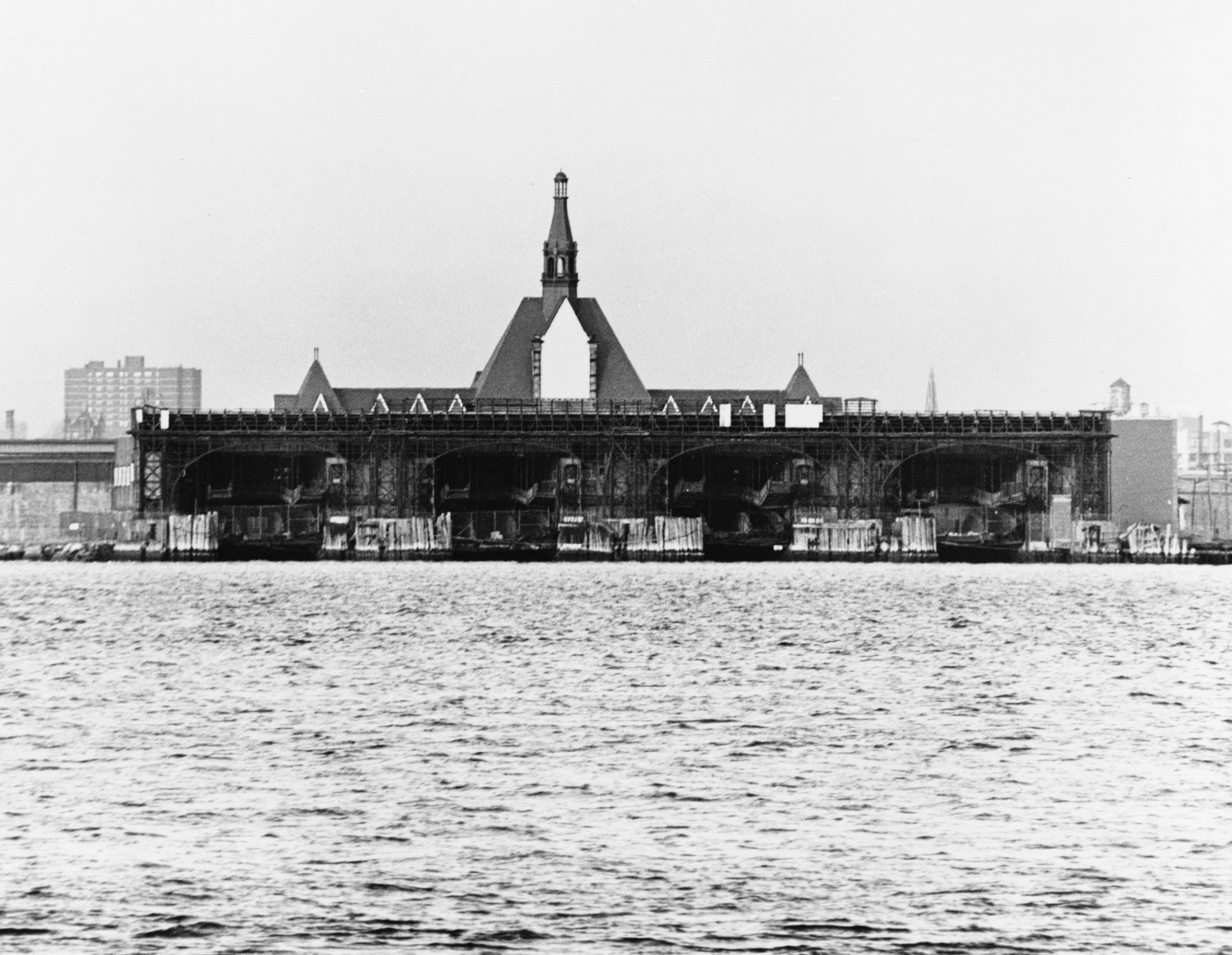 Jersey City Terminal's decaying ferry slips as they appeared during the 1970s. These have since been removed.
Jersey City Terminal's decaying ferry slips as they appeared during the 1970s. These have since been removed.Jersey City Terminal was expanded in 1914 to include more ferry slips but perhaps the building’s most impressive feature was its train shed that stretched over a football field in width by over two more in length (nearly 400 feet wide by over 800 feet long).
All in all, along with a substantial yard and staging tracks leading up to the station, Jersey City Terminal was a very beautiful building that one would have thought was built by a prominent railroad but the CNJ never reached more than a few hundred miles in length at its largest.
While the terminal played host to many commuter trains it never saw many well known passenger trains although it did serve:
- The Blue Comet (the CNJ’s regal passenger train)
- Queen of the Valley (CNJ)
- Raritan Clocker (CNJ)
- Williamsporter (CNJ)
- Hunterdon Commuter (CNJ)
- Crusader (Reading)
- Wall Street (Reading)
- B&O’s Royal Blue (Until 1958)
Today, save for the terminal herself and its train shed little evidence remains of the once sprawling railroad operations that went on along the Jersey City waterfront known as Communipaw Cove.
The tracks have long since been taken up and the terminal itself was purchased by the state in 1967 after the CNJ fell into bankruptcy after the Aldene Plan went into a affect on April 30th that year.
The idea meant to streamline passenger terminal services in New Jersey, moving all intercity and commuter trains to nearby Newark Penn Station. To read more about the history of the Jersey Central please click here.
This resulted in the Communipaw Terminal to lose virtually all of its passenger traffic, although it did allow the Central Railroad of New Jersey some savings in operating the complex.
A few years later the CNJ pulled out of Jersey City altogether in 1974 due to stifling taxes imposed by the city.
Today, the track area of Jersey City Terminal is now an expansive lawn and golf course with the terminal part of the Statue of Liberty and Ellis Island park complex.
Being that railroad tracks are still just nearby from the terminal it has been suggested that perhaps one day, particularly as highways become more congested and we look for “greener” ways to travel that commuter service will return to the terminal.
While this may never happen at least this beautiful
building has been preserved for future generations to appreciate its
architectural exquisiteness.
Recent Articles
-
Indiana's Dinner Train Rides In Jasper!
Jan 18, 26 01:54 PM
In the rolling hills of southern Indiana, the Spirit of Jasper offers one of those rare attractions that feels equal parts throwback and treat-yourself night out: a classic excursion train paired with… -
New Mexico's Dinner Train Rides
Jan 18, 26 01:37 PM
If your heart is set on clinking glasses while the desert glows at sunset, you can absolutely do that here—just know which operator offers what, and plan accordingly. -
New Hampshire ~ Murder Mystery ~ Dinner Train Rides
Jan 18, 26 01:10 PM
The state's murder mystery trains stand out as a captivating blend of theatrical drama, exquisite dining, and scenic rail travel. -
New York Valentine's Train Rides
Jan 18, 26 12:32 PM
At its best, the Adirondack Railroad delivers exactly what railfans and casual riders alike hope for: vintage coaches, classic depots, rivers and forests right outside the window. -
Washington Valentine's Train Rides
Jan 18, 26 10:50 AM
Whether you’re a dedicated railfan chasing preserved equipment or a couple looking for a memorable night out, CCR&M offers a “small railroad, big experience” vibe—one that shines brightest on its spec… -
Colorado Valentine's Train Rides
Jan 18, 26 10:49 AM
The Royal Gorge Route Railroad is the kind of trip that feels tailor-made for railfans and casual travelers alike, including during Valentine's weekend. -
Georgia Valentine's Train Rides
Jan 18, 26 10:42 AM
f you’ve ridden the SAM Shortline, it’s easy to think of it purely as a modern-day pleasure train—vintage cars, wide South Georgia skies, and a relaxed pace that feels worlds away from interstates and… -
New Jersey ~ Murder Mystery ~ Dinner Train Rides
Jan 17, 26 01:16 PM
There are currently no murder mystery dinner trains available in New Jersey although until 2023 the Cape May Seashore Lines offered this event. Perhaps they will again soon! -
West Virginia Dinner Train Rides In Elkins!
Jan 17, 26 01:08 PM
The D&GV offers the kind of rail experience that feels purpose-built for railfans and casual travelers. -
Virginia Dinner Train Rides In Staunton!
Jan 17, 26 11:55 AM
If you’ve ever wished you could pair a classic scenic train ride with a genuinely satisfying meal—served at your table while the countryside rolls by—the Virginia Scenic Railway was built for you. -
Florida Easter Train Rides
Jan 17, 26 10:23 AM
The cold weather rarely invades Florida and the state nearly always warm and balmy early spring temperatures. Learn more about where you can find Easter-themed train rides across the Sunshine State. -
Ohio Easter Train Rides
Jan 17, 26 10:13 AM
Ohio is home to several museums and excursion trains preserving the state's rich railroading heritage. A few of these locations host Easter-themed train rides each spring. -
Massachusetts Valentine's Train Rides
Jan 17, 26 09:58 AM
The Cape Cod Central Railroad (CCCR) blends classic New England scenery with heritage equipment, narrated sightseeing, and some of the region’s best-known “rails-and-meals” experiences. -
California Valentine's Train Rides
Jan 17, 26 09:53 AM
Operating out of West Sacramento, this excursion railroad has built a calendar that blends scenery with experiences—wine pours, themed parties, dinner-and-entertainment outings, and seasonal specials… -
South Carolina Dinner Train Rides
Jan 16, 26 11:13 PM
There is only location in the Palmetto State offering a true dinner train experience can be found at the South Carolina Railroad Museum. Learn more here. -
Rhode Island Dinner Train Rides
Jan 16, 26 11:01 PM
Despite its small size, Rhode Island is home to one popular dinner train experience where guests can enjoy the breathtaking views of Aquidneck Island. -
Pennsylvania's Thomas The Train Rides
Jan 16, 26 04:13 PM
"A Day Out With Thomas” train rides offer a unique opportunity for children and their families to engage in a magical and memorable experience, setting the stage for a full day of fun and adventure. -
Illinois's Thomas The Train Rides
Jan 16, 26 02:23 PM
In Illinois, the "A Day Out With Thomas" event offers a unique chance for families to immerse themselves in the enchanting world of Thomas and friends, creating memories that last a lifetime. -
New Jersey's Thomas The Train Rides
Jan 16, 26 02:11 PM
Here's a comprehensive guide to what you can expect at Day Out With Thomas events in New Jersey. -
Texas ~ Murder Mystery ~ Dinner Train Rides
Jan 16, 26 01:54 PM
Here’s a comprehensive look into the world of murder mystery dinner trains in Texas. -
Connecticut ~ Murder Mystery ~ Dinner Train Rides
Jan 16, 26 01:26 PM
All aboard the intrigue express! One location in Connecticut typically offers a unique and thrilling experience for both locals and visitors alike, murder mystery trains. -
New Hampshire Dinner Train Rides In N. Conway!
Jan 16, 26 10:47 AM
Tucked into the heart of New Hampshire’s Mount Washington Valley, the Conway Scenic Railroad is one of New England’s most beloved heritage railways -
Oregon Dinner Train Rides Near Mt. Hood!
Jan 16, 26 10:44 AM
The Mt. Hood Railroad is the moving part of that postcard—a century-old short line that began as a working railroad. -
Maryland's - Wine Tasting - Train Rides
Jan 15, 26 02:59 PM
This article delves into the enchanting world of wine tasting train experiences in Maryland, providing a detailed exploration of their offerings, history, and allure. -
Colorado's - Wine Tasting - Train Rides
Jan 15, 26 02:46 PM
To truly savor these local flavors while soaking in the scenic beauty of Colorado, the concept of wine tasting trains has emerged, offering both locals and tourists a luxurious and immersive indulgenc… -
Iowa ~ Wine Tasting ~ Train Rides
Jan 15, 26 02:36 PM
The state not only boasts a burgeoning wine industry but also offers unique experiences such as wine by rail aboard the Boone & Scenic Valley Railroad. -
Georgia's Wine Train Rides In Cordele!
Jan 15, 26 02:26 PM
While the railroad offers a range of themed trips throughout the year, one of its most crowd-pleasing special events is the Wine & Cheese Train—a short, scenic round trip designed to feel like a t… -
Indiana ~ Murder Mystery ~ Dinner Train Rides
Jan 15, 26 02:22 PM
This piece explores the allure of murder mystery trains and why they are becoming a must-try experience for enthusiasts and casual travelers alike. -
Ohio ~ Murder Mystery ~ Dinner Train Rides
Jan 15, 26 02:10 PM
The murder mystery dinner train rides in Ohio provide an immersive experience that combines fine dining, an engaging narrative, and the beauty of Ohio's landscapes. -
Nevada Dinner Train Rides In Ely!
Jan 15, 26 02:01 PM
If you’ve ever wished you could step through a time portal into the hard-working world of a 1900s short line the Nevada Northern Railway in Ely is about as close as it gets. -
Michigan Dinner Train Rides In Owosso!
Jan 15, 26 09:46 AM
The Steam Railroading Institute is best known as the home of Pere Marquette #1225 and even occasionally hosts a dinner train! -
Arizona's - Wine Tasting - Train Rides
Jan 14, 26 02:04 PM
For those who want to experience the charm of Arizona's wine scene while embracing the romance of rail travel, wine tasting train rides offer a memorable journey through the state's picturesque landsc… -
Arkansas's - Wine Tasting - Train Rides
Jan 14, 26 01:57 PM
This article takes you through the experience of wine tasting train rides in Arkansas, highlighting their offerings, routes, and the delightful blend of history, scenery, and flavor that makes them so… -
Tennessee ~ Murder Mystery ~ Dinner Train Rides
Jan 14, 26 01:42 PM
Amidst the rolling hills and scenic landscapes of Tennessee, an exhilarating and interactive experience awaits those with a taste for mystery and intrigue. -
California ~ Murder Mystery ~ Dinner Train Rides
Jan 14, 26 01:26 PM
When it comes to experiencing the allure of crime-solving sprinkled with delicious dining, California's murder mystery dinner train rides have carved a niche for themselves among both locals and touri… -
Illinois ~ Murder Mystery ~ Dinner Train Rides
Jan 14, 26 01:13 PM
Among Illinois's scenic train rides, one of the most unique and captivating experiences is the murder mystery excursion. -
Vermont's - Murder Mystery - Dinner Train Rides
Jan 14, 26 12:57 PM
There are currently murder mystery dinner trains offered in Vermont but until recently the Champlain Valley Dinner Train offered such a trip! -
Massachusetts Dinner Train Rides On Cape Cod!
Jan 14, 26 12:20 PM
The Cape Cod Central Railroad (CCCR) has carved out a special niche by pairing classic New England scenery with old-school hospitality, including some of the best-known dining train experiences in the… -
Maine Dinner Train Rides In Portland!
Jan 14, 26 11:31 AM
While this isn’t generally a “dinner train” railroad in the traditional sense—no multi-course meal served en route—Maine Narrow Gauge does offer several popular ride experiences where food and drink a… -
Kentucky Dinner Train Rides In Bardstown!
Jan 13, 26 01:14 PM
The essence of My Old Kentucky Dinner Train is part restaurant, part scenic excursion, and part living piece of Kentucky rail history. -
Kansas Dinner Train Rides In Abilene!
Jan 13, 26 12:44 PM
If you’re looking for a heritage railroad that feels authentically Kansas—equal parts prairie scenery, small-town history, and hands-on railroading—the Abilene & Smoky Valley Railroad (A&SV) delivers. -
Michigan ~ Murder Mystery ~ Dinner Train Rides
Jan 13, 26 11:24 AM
Among the lesser-known treasures of this state are the intriguing murder mystery dinner train rides—a perfect blend of suspense, dining, and scenic exploration. -
Virginia's - Murder Mystery - Dinner Train Rides
Jan 13, 26 11:11 AM
Among the state's railroad attractions, murder mystery dinner trains stand out as a captivating fusion of theatrical entertainment, fine dining, and scenic travel. -
Arizona Dinner Train Rides At The Grand Canyon!
Jan 13, 26 10:59 AM
While the Grand Canyon Railway does not offer a true, onboard dinner train experience it does offer several upscale options and off-train dining. -
Georgia Dinner Train Rides In Nashville!
Jan 13, 26 10:27 AM
If you’ve ever wished you could slow down, trade traffic for jointed rail, and let a small-town landscape roll by your window while a hot meal is served at your table, the Azalea Sprinter delivers tha… -
Indiana Valentine's Train Rides
Jan 12, 26 04:27 PM
If you’ve ever wished you could step into a time when passenger trains were a Saturday-night treat and a whistle echoing across farm fields meant “adventure,” the Nickel Plate Express delivers that fe… -
Ohio Valentine's Train Rides!
Jan 12, 26 04:20 PM
The Hocking Valley Scenic Railway offers one of the region’s most atmospheric ways to experience the Hocking Hills area: from the rhythmic click of jointed rail to the glow of vintage coaches rolling… -
Wisconsin's - Wine Tasting - Train Rides
Jan 12, 26 03:10 PM
Wisconsin might not be the first state that comes to mind when one thinks of wine, but this scenic region is increasingly gaining recognition for its unique offerings in viticulture. -
California's - Wine Tasting - Train Rides
Jan 12, 26 02:34 PM
This article explores the charm, routes, and offerings of these unique wine tasting trains that traverse California’s picturesque landscapes. -
Wisconsin Scenic Train Rides In North Freedom!
Jan 12, 26 02:20 PM
The Mid-Continent Railway Museum is a living-history museum built around the sights, sounds, and everyday rhythms of small-town and shortline railroading in the early 20th century, what the museum cal…

